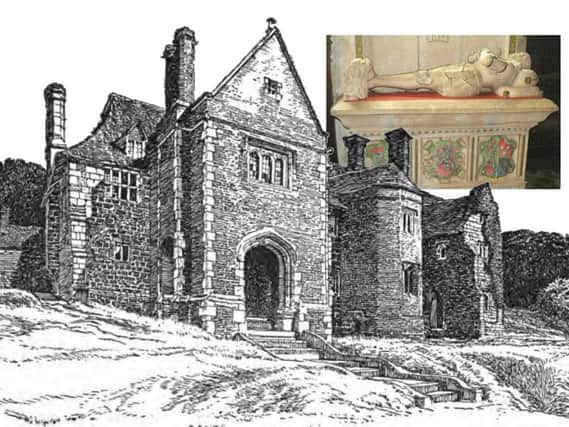Were children on the menu for Brede's ravenous ogre?


The cannibal was suspected to be Sir Goddard Oxenbridge who lived in Brede Place, an imposing edifice that still stands today. Rumours concerning the knight’s taste for young flesh may have emanated from a servant who had incurred Sir Goddard’s displeasure and been dismissed from service. True or not, the story spread far and wide.
Now it so happens that Sir Goddard was actually a God-fearing man who regularly attended church; his friends in the Sussex landed gentry dismissed the awful accusations and blamed them on uneducated peasant minds.
Advertisement
Hide AdAdvertisement
Hide AdEven so, the legend persists that fearful for their lives, the children of Brede felt they had no recourse other than to kill the alleged cannibal. The big problem was that Goddard was over seven feet tall and possessed of immense strength. Furthermore due to sorcery he could not be dispatched by weapons of metal and thus was immune to being murdered by swords and knives.
Artfully, the children devised an ingenious solution to the conundrum, one that would make Goddard's death almost as grisly as the terrible fate that befell the young ones he supposedly killed.
The nobleman being very fond of a drink, one day a band of surprisingly bold youngsters met him out on the road and told him they had a keg of grog he was free to enjoy. The giant happily accepted the gift. Maybe he thought the children were currying favour in the hope they would not themselves become his curry!
In any event, the ploy worked. Gullible Goddard imbibed a copious quantity of exceptionally strong liquor and eventually collapsed in a drunken stupor. The children had hidden a huge wooden saw with very sharp teeth in the undergrowth. Retrieving this, they set upon the comatose knight and promptly cut him in half. The notorious Brede Giant would feast on infants no more.
Advertisement
Hide AdAdvertisement
Hide AdIt is said that Goddard still haunts the scene of his demise - the “Groaning Bridge” in Stubb Lane. Indeed, a tad over a century ago the Society for Psychical Research came to investigate unexplained noises in the vicinity. Sir Arthur Conan Doyle was a member of this body and was certainly aware of the Brede Giant legend. Given that Conan Doyle was well away with the fairies (literally - he was an ardent believer in the existence of tiny winged people!) the chances are he thought the tale to be true.
The real life Sir Goddard Oxenbridge was born in 1478 into a noble family with royal connections. Brede Place dates from 1350 but Sir Goddard had the house considerably improved in his tenure. He was Sheriff of Sussex in the years 1506, 1512 and 1519 and was created Knight of the Bath in 1509 on the occasion of Henry VIII’s coronation.
His first wife, Elizabeth Etchingham, bore him a son, Thomas. He and his second wife Anne Fiennes produced a daughter, Elizabeth, who became Catherine Parr's lady-in-waiting. Another son served as Constable of the Tower of London. Sir Goddard Oxenbridge died in 1531. His impressive tomb in Brede’s St. George’s Church is topped by a splendid armour-clad effigy. His descendents lived in the Brede house until 1616.
Sir Goddard was Catholic and it’s possible that the stories of cannibalism were spread by Protestants wishing to discredit the family. However, I think there is a much more plausible explanation. Around 1700 a then uninhabited Brede Place fell into disrepair and it’s believed that local smugglers began using the building as a handy store for their contraband. To deter prying eyes, it would make perfect sense to spread tales of ghostly goings-on. Every plot of the cartoon series “Scooby-Do” revolves around a similar scenario!
Advertisement
Hide AdAdvertisement
Hide AdThe US author and war correspondent Stephen Crane rented Brede Place in 1898. His best-known book is “The Red Badge of Courage”, a tale of the American Civil War. Before he and his wife Cora even had time to move in the writer was commissioned to report on the Spanish-American War in Cuba where he met Teddy Roosevelt, leader of the famous “Rough Riders”.
Following Crane’s return, the couple lived in Brede Place. Though plagued by ill-health and chronic financial problems, Crane invited lots of fellow literary luminaries to the house; these included Joseph Conrad and H.G. Wells who came for a Christmas party in December 1899. Other guests were Rudyard Kipling and Henry James, author of the ghost story “Turn of the Screw”, who must have enjoyed the gruesome legend of the Brede Giant.
"Peter Pan” creator J.M. Barrie also visited and apparently found inspiration for his Captain Hook character. A former parson of St. George’s Church was John Maher, who sported a hook in place of his left hand. He claimed he’d lost the hand in an accident but in fact he had once been a pirate. He was unmasked when a former shipmate tracked him down and spilt the beans after his blackmail attempt failed.
In the early summer of 1900, Stephen and Cora travelled to Germany’s Black Forest in the hope that the writer’s health would be restored by a stay in a spa. It wasn’t to be; Crane died on 5th June 1900, aged just 28.